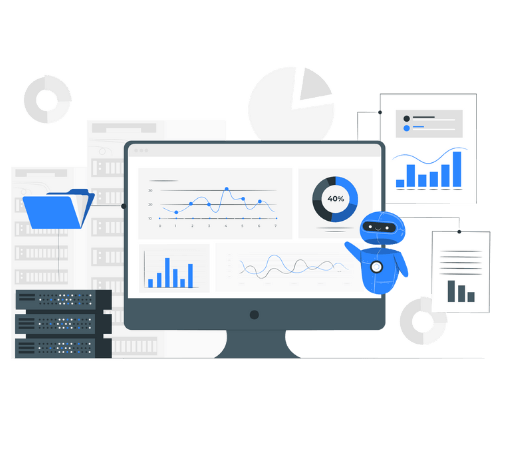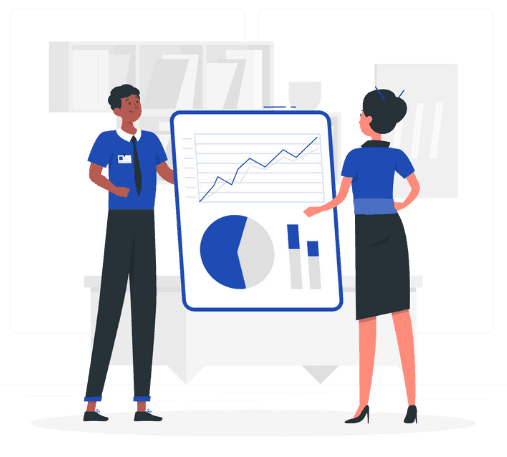
What We Do In Data Warehousing Services
Our team believes in the power of data to help you make smarter decisions. That's why we provide a full range of tried and tested data warehouse solutions that can help you develop your own data warehouse and take advantage of the information it contains.
We provide end-to-end support for all phases of the development lifecycle from architecture, design, and implementation to ongoing management and maintenance. Our experts collaborate with you to identify your business requirements and develop a solution that meets those needs.
Top Data Warehouse Services We Offer
Data Warehouse Consulting
When it comes to data warehousing, there are a lot of moving pieces to consider. You need to make sure that you have the right hardware, software, and storage for your new warehouse. We'll help you choose the right hardware, software, and storage for your needs. We work with you on how to migrate your current data into the new system, ensuring that everything goes smoothly and painlessly in the process.
Data Warehouse Designing
The first stage in the development of a data warehouse is the design of the data warehouse itself. This involves identifying what information should be included, how it should be structured and organized, and how it will be accessed by end users. The design phase is also where you begin to determine which tools will be used to create your data warehouse solutions.
Data Warehouse Development
We develop the data warehouse using a variety of tools and technologies. Our data team members are experienced in various programming languages and can develop the system according to your business specifications. The development includes building a data warehouse from scratch or by modifying an existing database system. It can be performed in two ways: Extract-Transform-Load (ETL) and Replication.
Data Warehouse Implementation
Data Warehouse Implementation is a service that provides a comprehensive approach to data warehousing services. Our team will help you create a plan for your needs and implement it using the best practices for your industry. We will also provide training and support throughout the process to ensure your team has all the resources they need to succeed.
Data Warehouse Migration
When it comes time to migrate from one data warehouse system to another, there are many things that can go wrong and even more opportunities for problems if you don't have an experienced data expert on hand. Hence we've set up our company as a full-service solution for all of your data warehousing needs from consulting through migration and support after the fact.
Data Warehouse Support
We offer support for our clients' existing data warehouses solutions as well as those developed by us. We help you maintain and enhance your data model over time by providing regular maintenance, enhancements, and upgrades.
Growth of OneClick IT Consultancy
- 12+Years of Experience
- 1000+Project Deployment
- 200+Expert Developers
- 50+Active Clients
- 30+Frameworks
Know How We Can Simplify Your Data Warehouse
How We Help Businesses Grow With Data Warehouse Services

Data warehouses consulting have a number of benefits for businesses. We can help companies analyze past data, predict future outcomes, and make more informed decisions about their business operations. These insights lead to better decision-making, which in turn leads to increased profits for the company.
Our Data warehouse services also help companies improve customer experience by giving them insight into what customers want and expect from them. This can help companies better anticipate the needs of their customers so they can provide them with what they want and need when they need it most.
Types Of Data Warehouses Are There
Enterprise Data Warehouse (EDW)
These types of DWs contain the most up-to-date information from multiple sources including external systems. This type of DW is used by big companies such as Walmart and Amazon where they collect all their internal and external data from different sources in one place so that they can provide better services to their customers.
Data Mart
A data mart has a smaller capacity than an EDW, but it also provides faster access for users who only need to analyze specific parts of an organization's data set without having access to everything else about the firm or entity being analyzed.
Why Do Businesses Need A Data Warehousing Services

A data warehouse services is a central repository for all your business data. It brings together various sources, such as transactional databases and company reporting systems, into a single location where the information can be combined, transformed, and analyzed to provide valuable insights. The data warehouse services is designed with the goal of creating one version of the truth across your organization.
The data warehouse solutions is to consolidate diverse sources of information in a single location that enables fast access to current information required by decision-makers. This also eliminates redundancy across different databases by consolidating them into one place which makes it easier for businesses to make strategic decisions based on up-to-date information rather than relying on outdated reports or spreadsheets.
Discover The Power of Automated Data Warehousing Services
How Does the Data Warehouse Work
We Are Experts In Data Warehouse Tools










A Few Questions Can Make A Big Difference. We Are Ready To Answer Them All.

Why Choose OneClick For Data Warehouse Services
- Real-time Analytics: Get real-time insights - reports of each data of your business activity.
- Specific Recommendations: Custom solutions are recommended based on our profound analysis.
- Accurate Reporting: We generate 100% accurate reports with our solutions.
- Solid BI Architecture: State-of-the-art architecture is selected for every project assigned to us.
- Experts of Data: Our Data team has expertise in the most advanced BI and warehousing tools.
FAQs for Data Warehouse Services
Data warehousing is an investment. The cost of data warehousing services depends on the size of your data and its complexity, as well as other factors like the speed at which you need it to run. For example, a small business might need a simple data warehouse with only basic reports available on demand. However, if you're looking for more advanced analytics that is updated in real-time, then your project could be more expensive.
Data warehousing is the process of storing large amounts of data in a central location. Data warehousing is used to store data from multiple sources, such as web servers or business systems. It allows you to organize your organization's information and make it easier for users to access and analyze the information.
You can make better business decisions. Data warehouses consulting are used by businesses of all sizes, from small retailers to large global corporations. A data warehouse can help you make better marketing decisions, operational decisions, and financial decisions, as well as strategic choices that will help grow your business. They can also be used with predictive analytics software to predict customer behavior based on past transactions or behaviors.
ETL is an abbreviation for Extract, Transform, Load. It is the process of extracting data from various sources and transforming it into a predefined format before loading it into a data warehouse. This is done either periodically or on an event-based model (e.g., whenever there's a new purchase order).
ELT stands for Extract, Load, and Transform. The data extraction happens first as described above; then the transformed data is loaded into the warehouse, and lastly, there's some kind of transformation or manipulation done to this loaded copy before being made available for use by end users who are part of your organization's business intelligence team or other stakeholders who need access to this information in order to perform their job functions effectively.



